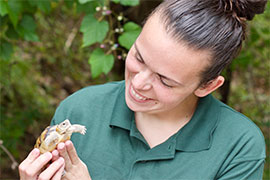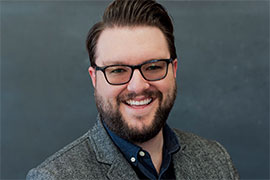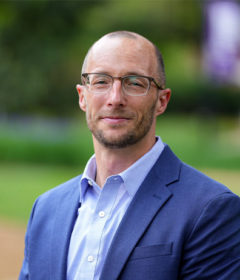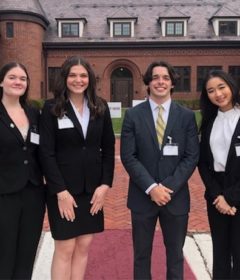Showcase of Transformation

Editor’s note: This article appears in the Fall 2018 issue of Stetson University Magazine.

For Danielle (Leopold) Regan ’10, life is a zoo — literally. Regan was majoring in biology at Stetson and planning to become a high school agriculture teacher. Then her SURE (Stetson Undergraduate Research Experience) grant changed everything.
Goodbye, agriculture. Hello, banded water snakes, Panamanian golden frogs, Egyptian tortoises and Chinese alligators.
“I found my passion for these scaly creatures when I did my student research project at Stetson,” said Regan.
As a student of Terence Farrell, Ph.D., professor of biology, Regan had become intrigued by some of his field-based research projects, especially a native-snake-versus-invasive-catfish study. Her SURE project required her to care for a lab with roughly 30 banded water snakes — her “first experience with captive animal husbandry,” she joked, adding, “My professors immersed me into the world of reptiles, and I was hooked.”
Today, Regan is area manager of the Maryland Wilderness and Panamanian Golden Frog Team at the Maryland Zoo in Baltimore, where she frequently handles those exotic animals. She has worked the past seven years as a zookeeper.
Regan’s transformation went on display during her senior year when she presented at Stetson Showcase — a daylong event each spring where students share their research through oral presentations, portfolios, posters, readings, music and theater performances, art exhibits, and multimedia work.
Regan’s showcase detailed her research on whether banded water snakes, a species native to Florida, could “consume a far more challenging prey,” an invasive species of “armored” catfish known as the brown hoplo.
Stetson Showcase celebrated its 20th anniversary in spring 2018, with student programs ranging in topics from media portrayals of African-American women in the workplace and Godzilla as a metaphor for nuclear war to social media’s impact on cryptocurrency. In all, there were more than 200 presentations encompassing medicine, literature, business, international relations, science, music, art, religion, philosophy, politics, race, gender, sexuality and other fields.
Participation in SURE, a competitive grant program in which selected students undergo an eight-week, research-intensive experience during the summer under the mentorship of a Stetson faculty member, is required to present at Stetson Showcase.
Often, as was the case with Regan, Stetson Showcase is a launching point for careers. Other times, Showcase simply represents the culmination of an undergraduate’s study. Either way, the program speaks to “an embarrassment of riches in undergraduate research” at the university, according to Kimberly Reiter, Ph.D., associate professor of ancient and medieval history and chair of the Stetson Undergraduate Research Committee. Reiter also serves as a national councilor for the Undergraduate Research Directors Committee for the Council of Undergraduate Research.
While many universities have showcases for students in STEM (science/technology/engineering/math) and honors programs, Stetson Showcase is “more comprehensive,” Reiter said, adding that it’s the “oldest comprehensive showcase day in the country.”
“We have a wealth of research from which to draw. I go to [national council] meetings, and I have to try very hard not to keep interjecting, because a lot of talk is about ‘How do we get undergrads to do research?’ … When it comes to Showcase, we don’t have to scramble for people. We’ve got them,” Reiter asserted.

Students design their showcases for other students and faculty plus the general public, and their work is judged not only on content, but also how that content is communicated.
VIENNA BY STORM
Soprano Jenna Siladie ’11 made her first trip abroad to Austria with a SURE Grant to study lied (German art song — that is, poetry set to classical music) at the Franz Schubert Institut.
“I knew immediately that I belonged there and had to someday make it back, as Vienna is the epicenter of all things opera and music,” Siladie said. “At the Franz Schubert Institut, I was working with a high caliber of other artists, singers and musicians, and therefore I was able to absorb such a deeper level of musicality and understanding of this musical art form and its poetry.”
Siladie’s Stetson Showcase project challenged her to find ways to explain this “seemingly foreign musical genre in very down-to-earth ways,” she said. “I enjoyed showing how interconnected the music and poetry are, and giving passages that showed how Schubert wrote what a tree rustling in the winds sounded like, or how Brahms ‘composed’ a stormy night.”
After earning her degree in vocal performance from Stetson, Siladie completed her Master of Music from Yale University and was a member of the Santa Fe Opera Company for two seasons. She recently made her European debut, singing Wagner’s “Götterdämmerung.”
“Never in a million years did I think I’d be singing in this opera as my debut into German stages,” Siladie said. “It was so fulfilling just to see how much the audiences truly love this music.”
Siladie lives in Vienna, where she sings as an ensemble member with the opera house Theater an der Wien. It’s far from her Stetson home, but lessons learned remain near.
“Even now, I sing many times for people who have never been to the opera or to a vocal recital before, and it’s always a pleasure for me to show the humanness and accessibility that comes with these stories and songs,” she said.

PRACTICAL THEOLOGIAN
Michael Paul Cartledge II ’13 majored in communication and media studies at Stetson, and today he is using those skills as a doctoral student in practical theology at Princeton Theological Seminary.
“Practical theology focuses on the life of the Christian community — specifically its practices and mission in its particular social context,” explained Cartledge, who plans to teach after earning his doctorate. “In my own work, I use sociological research methods to better understand the experiences of people suffering from depression and explore how Christian communities might … care for those who are suffering.”
Through a SURE Grant, Cartledge examined “the artistic and expressive activities of a hip, young evangelical congregation in an urban context.” Ultimately, he showed how this faith community “used art to make the abstract concept of community a more tangible reality.”
To read the remainder of the article, starting on Page 40, click here.



